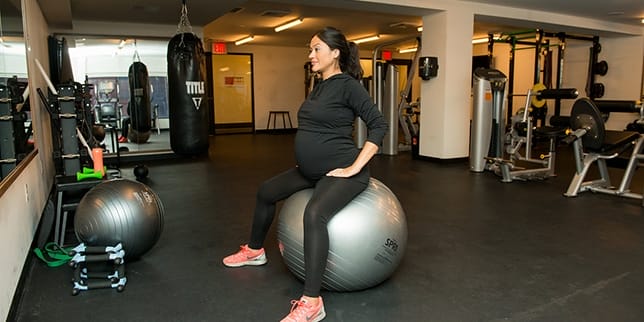Yoga poses for labor

5 poses you might want to strike when baby’s bearing down.
Table of Contents
- 5 of the best yoga poses for labor
- Additional Comfort Measures
- FAQ: Prenatal Yoga and Comfort Measures for Labor
- Q1: Can prenatal yoga actually help with labor?
- Q2: What are some beneficial yoga poses for labor?
- Q3: Is squatting really effective during labor?
- Q4: How does the Rocking Cat pose benefit labor?
- Q5: Can I still benefit from certain poses if I have an epidural?
- Q6: What are some other comfort measures I can use during labor besides yoga?
- Q7: How can water therapy help during labor?
- Q8: Are essential oils safe to use during labor?
- Q9: How important is partner support during labor?
- Q10: Can I use yoga and these comfort measures if I plan to have an unmedicated birth?
Even if you’ve never done a single downward dog in your entire life, there’s no time like pregnancy to get into a yoga routine. The benefits of prenatal yoga are many—from emotional to physical to mental and beyond. But it’s also an important way to prep for birth, as you get your body and brain in shape to bring a tiny human into the world.
Deb Flashenberg, owner of the Prenatal Yoga Center in NYC and mom of two, says that prenatal yoga can not only help a mama-to-be gain community and support, and build body confidence for the wild ride that is birth, but it can also provide coping mechanisms for birth and go-to movements to ease discomfort. “At Prenatal Yoga Center, we teach familiar movements that can translate to labor and address the issues, aches and pains many women experience during pregnancy.”
Even if you’re not planning to have an unmedicated birth, yoga can make a big difference during your labor.
5 of the best yoga poses for labor
Below, Debra shares five yoga poses that may be useful on the big birth day.
1. Squat
When to use it: Any time during labor, and also in the pushing period!
Why is it so great? Squatting opens the outlet of the pelvis on average 28% wider than if one was lying down. It also uses gravity to add pressure directly to the cervix which can encourage dilation.
 How to get do it: First, it is important to open the ankles and calf muscles. The first picture shows how to lengthen the back of your leg and release your calves and ankle joint. Julia, the model, is extending one leg back at at time, engaging her knee, and reach back through her heel. Be mindful not to dump into the lower back and create a big sway, instead, slightly angle your tailbone towards the ground.
How to get do it: First, it is important to open the ankles and calf muscles. The first picture shows how to lengthen the back of your leg and release your calves and ankle joint. Julia, the model, is extending one leg back at at time, engaging her knee, and reach back through her heel. Be mindful not to dump into the lower back and create a big sway, instead, slightly angle your tailbone towards the ground.

Next, she opens the adductors, the inner thigh muscles. In this pose, Julia is standing with her feet about 3 feet apart and leans over, supporting her hands on blocks. She turns both feet slight out, bend one knee and sits into that hip, while coming onto the heel of the other foot, straightening and very actively flexing the foot. Then she will switch sides.
 Last, we are ready to move into an unsupported squat. Since Julia still has some tightness in her legs, we fold a blanket up to prop her heels higher. Then Julia lowers down.
Last, we are ready to move into an unsupported squat. Since Julia still has some tightness in her legs, we fold a blanket up to prop her heels higher. Then Julia lowers down.
Alignment note: Once down, it is important to remember to lift the inner arches and inner knees and not balance on the ball of the foot and try to have the toes point forward. If the toes are dramatically pointing outwards this is creating less space in the pelvic outlet. Also, the weight should be distributed evenly on the foot.
Another squatting option is a partner squat. Hold each other’s forearms firmly, then the squatter gently descends down. Alignment note: once down, the squatter should learn back and the standing partner take the weight. To save the standing partner’s back, remember to slightly keep a bend in the knees and lean back—it is like water skiing!
2. Rocking Cat
When to use it: This can be used at any time during the first stage of labor.
Why is it so great? This sequence of movement takes pressure of the mother’s back, encourages optimal fetal position since the mother’s belly is facing downward, the rocking motion also encourages the baby to navigate its way through the pelvis seeking the best fit and birthing position. Finally, by linking breath and movement through this rocking motion, the mother is establishing rhyme, ritual and relaxation.

 How to do it: The laboring and birthing position is done on all fours. If the woman has sensitive knees, she can put a yoga mat, blanket or towel underneath her knees. Her knees are hip distance of wider and her hands are shoulder distance. As she inhales, she can lengthen her spine forward and as she exhales, she would round her back, rocking her hips back towards, but not all the way towards her heels. Continue this as long as it feel good!
How to do it: The laboring and birthing position is done on all fours. If the woman has sensitive knees, she can put a yoga mat, blanket or towel underneath her knees. Her knees are hip distance of wider and her hands are shoulder distance. As she inhales, she can lengthen her spine forward and as she exhales, she would round her back, rocking her hips back towards, but not all the way towards her heels. Continue this as long as it feel good!
3. Side Lying
When to use it: This pose is great for when a mom is tired and needs to rest or If she has taken an epidural and her movement is now limited to switching from side to side.
Why is it so great? One of the main benefit of this position is the internal rotation that is created by lifting the ankle of the top leg which creates more opening in the pelvic outlet This can be extremely beneficial to help correct and prevent a baby that is in the OP (occiput posterior) position. The position of side lying with internal rotation is similar to the usage of a peanut ball (literally a big 35 or 45 cm inflatable ball that is shaped like a peanut) The research, while limited, for the peanut ball is the first and second stage of labor is shortened and less likeliness for instrumental (forceps or vacuum) is decreased.
 How to do it: Set up the bolster or stack of pillows with the slight downward slope. Lay on your preferred side and mindfully place the top leg on the support with the ankle being higher than the knee. Extend the bottom leg straight and roll towards the belly. You can add a pillow or folded blanket under your head for extra support.
How to do it: Set up the bolster or stack of pillows with the slight downward slope. Lay on your preferred side and mindfully place the top leg on the support with the ankle being higher than the knee. Extend the bottom leg straight and roll towards the belly. You can add a pillow or folded blanket under your head for extra support.


4. Baddha Konasana
When to use it: This pose is very useful during the first stage of labor especially if the mother has an epidural and is confined to bed or during early labor.
Why is it so great? For those who can not move around, this pose gently stretch the pelvic floor and inner thighs and use gravity to help baby to descend.

 How to do it: Sit with your hips lifted on either a blanket or bolster. bring your feet together and knees apart. Keeping a long spine, start to hinge forward. If the mother is experiencing pain in the lower back to the left or right side of the sacrum, this could be sacroiliac pain, at which point I advise the woman to move her feet further and place support underneath her knees.
How to do it: Sit with your hips lifted on either a blanket or bolster. bring your feet together and knees apart. Keeping a long spine, start to hinge forward. If the mother is experiencing pain in the lower back to the left or right side of the sacrum, this could be sacroiliac pain, at which point I advise the woman to move her feet further and place support underneath her knees.
5. Wall Lean/Shoulder Stretch
When to use it: In prenatal yoga class we use this pose to open the shoulders and stretch the back. In labor it can be used any time—even for pushing!
Why is it so great? This is a natural position for many women to assume during labor. The leaning forward action takes pressure off the lower back and many women innately shift their hips around. The uprightness of the position uses gravity to help baby downward and the movement of the pelvis helps the baby navigate space and corkscrew through the pelvis. Much like the all-fours position of rocking cat, this pose also take pressure off the lower back and the lower back is exposed so the mother can receive massage, a hot water bottle or applied pressure to the sacrum—all of these are very welcome comfort measures for the mom!

 How to do it: Place forearms against the wall, the hands can be clasped if that is comfortable. Walk feet back so the belly is facing downward. Be mindful not to overly arch the back. Feet are wide and knees are soft. Feel free to swing and sway hips and move that baby around!
How to do it: Place forearms against the wall, the hands can be clasped if that is comfortable. Walk feet back so the belly is facing downward. Be mindful not to overly arch the back. Feet are wide and knees are soft. Feel free to swing and sway hips and move that baby around!
Additional Comfort Measures
Incorporating yoga into your prenatal care is an empowering way to prepare your body and mind for the birthing process, but combining yoga with other comfort measures can further enhance your experience. Here are additional tips to complement the yoga poses mentioned above, offering you more tools for comfort and ease during labor.
1. Breathing Techniques:
- Focused Breathing: Practice deep, focused breathing to help manage pain and stress during contractions. Each breath should be deep and slow, helping to maintain calmness and control.
- Visualized Breathing: Imagine each breath flowing to the area of discomfort, bringing relaxation and pain relief with each exhale.
2. Massage and Touch:
- Counterpressure: Applying firm pressure to the lower back, hips, or sacrum can significantly reduce discomfort during contractions.
- Massage: Gentle massage on the shoulders, back, and feet can provide relaxation and reduce tension.
3. Movement and Position Changes:
- Walking: Gentle walking can help progress labor by using gravity to encourage the baby to descend.
- Swaying: Swaying or dancing in a slow, rhythmic motion can be soothing and may help with the alignment of the baby.
4. Water Therapy:
- Shower: A warm shower can be soothing, especially directing the water flow onto your back or abdomen.
- Bath: Soaking in a warm bath can provide a sense of weightlessness and relieve pressure on the pelvic floor.
5. Aromatherapy:
- Essential Oils: Scents like lavender, chamomile, and peppermint can be calming and help manage nausea. Use a diffuser or apply diluted oils to pulse points with care and under the guidance of a professional.
6. Sound and Music:
- Calming Sounds: Playing soothing music, nature sounds, or white noise can create a tranquil environment that facilitates relaxation.
- Vocalization: Making low-pitched sounds or humming during contractions can help release tension and may enhance pain management.
7. Support and Encouragement:
- Partner Support: Having your partner, a friend, or a doula provide continuous support, encouragement, and physical comfort can make a significant difference in your labor experience.
- Positive Affirmations: Repeating positive affirmations can boost confidence and reduce anxiety. Phrases like “I am strong,” “My body is capable,” and “Each contraction brings me closer to my baby” can be powerful.
Embracing Your Unique Journey
Remember, each labor and delivery experience is unique. What works for one person might not work for another. It’s essential to stay flexible and open to trying different comfort measures to find what works best for you. Engaging in prenatal yoga is a great starting point for preparing your body and mind for birth, but incorporating a variety of techniques can provide a comprehensive approach to managing discomfort and enhancing your overall birthing experience.
If you’re looking for more information on yoga poses for labor, visit the National Library of Medicine.
FAQ: Prenatal Yoga and Comfort Measures for Labor
Q1: Can prenatal yoga actually help with labor?
A1: Yes, prenatal yoga not only builds body confidence and support but also provides coping mechanisms for birth and movements to ease discomfort during labor.
Q2: What are some beneficial yoga poses for labor?
A2: Five useful poses include Squat, Rocking Cat, Side Lying, Baddha Konasana, and Wall Lean/Shoulder Stretch, each offering unique benefits such as opening the pelvis, encouraging optimal fetal position, and relieving back pressure.
Q3: Is squatting really effective during labor?
A3: Absolutely. Squatting can open the pelvis wider than when lying down, using gravity to encourage dilation and assist in the pushing stage.
Q4: How does the Rocking Cat pose benefit labor?
A4: This pose takes pressure off the mother’s back, encourages the baby to find the best birthing position, and links breath with movement for relaxation.
Q5: Can I still benefit from certain poses if I have an epidural?
A5: Yes, poses like Side Lying and Baddha Konasana are great for those with an epidural, helping with pelvic opening and baby descent.
Q6: What are some other comfort measures I can use during labor besides yoga?
A6: Techniques include focused breathing, counterpressure and massage, movement and position changes, water therapy, aromatherapy, calming sounds, and support from a partner or doula.
Q7: How can water therapy help during labor?
A7: A warm shower or bath can soothe discomfort, with the warmth relieving pressure and providing a sense of weightlessness.
Q8: Are essential oils safe to use during labor?
A8: Yes, when used correctly. Essential oils like lavender and chamomile can be calming, but should be used under professional guidance and properly diluted.
Q9: How important is partner support during labor?
A9: Incredibly important. Continuous support, encouragement, and physical comfort from a partner, friend, or doula can significantly improve the labor experience.
Q10: Can I use yoga and these comfort measures if I plan to have an unmedicated birth?
A10: Yes, these techniques are beneficial for any type of birth, including unmedicated. They provide physical and mental support, regardless of your birth plan.
Photography by Stylish & Hip Kids for Well Rounded.





































